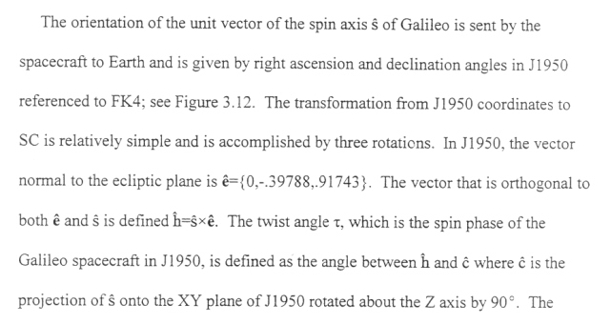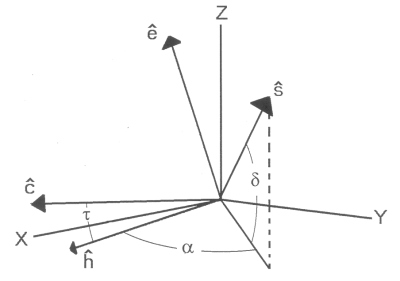Investigation of the Magnetosphere of Ganymede with Galileo's Energetic Particle Detector
Ph.D. dissertation by Shawn M. Stone, University of Kansas,
1999.
Copyright 1999 by Shawn M. Stone. Used with permission.
3.5 Coordinate Transformations and SPICE Kernels
Now that all the pertinent coordinate systems and reference frames have been defined, it is time to develop the transformation matrices between systems. The transformation needed depends on what system you are in and what system you wish to go to. The data taken by the EPD instrument is known in spacecraft coordinates. However, the data is more easily interpreted when it is in a physical system such as JSMIII when one is looking at where the radiation is coming from and going to physically. It is necessary to transform from spacecraft coordinates (SC) to a planetocentric (or body centered) frame for data analysis. The most efficient way to do this is to transform from the SC frame to an inertial frame such as J2000 or J1950 and then into another desired body frame.
3.5.1 Transformation from J1950 to SC



3.5.2 Transformation from SC to Planetocentric Coordinates
The transformation from spacecraft coordinates to planetocentric coordinates of a body is accomplished with the SPICE kernel system [NAIF, 1991], a means for providing ancillary observation geometry data and related tools used in the planning and interpretation of science instrument observations returned from planetary spacecraft. This system is defined in detail in Appendix A.SPICE kernels contain all the necessary precalculated information to transform between inertial reference frames and body centered frames, and they do so from the J2000 frame of reference. For example, the transformation from SC to GSII begins with specification of an ephemeris time such as 19:00:00 UTC for the G2 encounter. The SPICE kit uses this ephemeris time to calculate the transformation matrix from J1950 to J2000 (RJ1950_J2000) and the transformation matrix from J2000 to GSII (RJ2000_GSII). Using the transpose of Equation [3.4] the transformation from SC to GSII is then made by
|
|
[3.5] |
The transformation to any other body frame proceeds in the same manner; all that is needed is the SPICE body code described in Appendix A.
3.5.3 Transformation from Body Centered to Magnetic Coordinates
To make the transformation from a body centered frame--“body” referring to spacecraft as well as moons and planets--to the magnetic coordinate frame requires two vectors . The first, of course, is the magnetic field vector, and the second is the radius vector from Galileo to Jupiter. Assuming that each of these is in a known body centered frame, the transformation can be constructed as follows (Figure 3.13 illustrates this transformation). The first rotation is made about the body centered y axis by an angle
|
|
[3.6] |
The second rotation is made about the new x' axis by an angle
|
|
[3.7] |
The last rotation fixes the x'' axis in space by rotating about z'' until the radius vector to Jupiter lies in the z''x'' plane. This angle is
 |
[3.8] |
From this coordinate system it is simple to reference the pitch and phase angles of the particles as described in section 3.4.3.
 |
Figure 3.13 Illustration of the transformation from a body-centered coordinate system to the magnetic field coordinate system. (A) Rotation about the Y axis by an angle a. This puts the B vector in the Z'Y' plane. (B) Rotation about the X' axis by angle b. This puts the B vector parallel to the Z'' axis. (C) To reference the polar angle Φ, the radius vector to Jupiter, R'', is rotated about Z'' by an angle c. (D) The completed transformation. The EPD look direction is shown in this coordinate system. Pitch α and phase Φ angles of the particles that hit the detector are simply the angles that orientate the EPD look direction in this system. |
Next: 3.6 State Vectors and EPD Look Directions
Return to dissertation table of contents page.
Return to main
Galileo Table of Contents Page.
Return to Fundamental
Technologies Home Page.
Updated 8/23/19, Cameron Crane
QUICK FACTS
Mission Duration: Galileo was planned to have a mission duration of around 8 years, but was kept in operation for 13 years, 11 months, and 3 days, until it was destroyed in a controlled impact with Jupiter on September 21, 2003.
Destination: Galileo's destination was Jupiter and its moons, which it orbitted for 7 years, 9 months, and 13 days.






